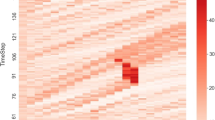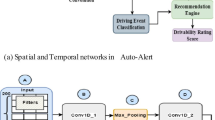Abstract
Dead reckoning, within the realm of emergency vehicle preemption, entails the art of deducing the present position and course of an emergency vehicle (EV), such as a police cruiser, ambulance, or fire engine. This deduction is rooted in prior knowledge and measurements, particularly vital when the accuracy of the Inertial Measurement Unit (IMU) is susceptible to decline amidst challenges like urban canyons, tunnels, or inclement weather. To surmount this challenge, we introduced a technique for estimating the EV’s position, termed “dead reckoning,” which leverages a deep neural network (DNN) in conjunction with an Inertial Measurement Unit (DNN-IMU). This self-contained system equips EVs with reliable navigation capabilities. In our initial phase, we designated six test routes, recording velocity, attitude (pitch and roll angle), and position data before integrating them with the DNN-IMU. These datasets underwent comprehensive training and testing. Throughout this process, we gauged the performance of the DNN-IMU using four key performance metrics, contrasting its effectiveness with prevailing methods. Simulation outcomes strongly suggest the efficacy of our proposed DNN-IMU across all six test routes. Notably, when tested in two different routes under GPS outage conditions, our method outperformed others, yielding significantly greater accuracy (92.45% for trajectory-1 and 93.62% for trajectory-2).














Similar content being viewed by others
Data Availability
The data that support the findings of this study are available from the corresponding author upon reasonable request.
Abbreviations
- EVs:
-
Emergency vehicles
- DNN:
-
Deep neural network
- DNN-IMU:
-
Deep neural network and an extended Kalman filter-based Inertial Measurement Unit
- EVP:
-
Emergency Vehicle Preemption
- IR-EVP:
-
Infrared based EVP
- GPS:
-
Global Positioning Systems
- SMS:
-
Short message service
- GNSS:
-
Global navigation satellite system
- ILP:
-
Integer linear programming
- GTT:
-
Ground-truth trajectories
- RMSE:
-
Root means square error
- MAE:
-
Mean absolute error
- CD:
-
Coefficient of determination
- ECM:
-
Efficiency coefficient method
- OI:
-
Overall index
- GPSO:
-
GPS outage
- ENU:
-
East–north–upward
- LSTM:
-
Long-Short Term Memory
- FCL:
-
Fully connected lay
- NLL:
-
Negative log-likelihood
References
Sundar, R., Hebbar, S., Golla, V.: Implementing intelligent traffic control system for congestion control, ambulance clearance, and stolen vehicle detection. IEEE Sens. J. 15(2), 1109–1113 (2015)
Booth, A., Bosher, L., Chmutina, K.: The protection of crowded places from terrorist threats: Does protective security advice meet the needs of security managers? Secur. J. 1–14 (2022). https://doi.org/10.1057/s41284-022-00332-7
Al-Asadi, M., Taşdemir, Ş, Örnek, K.K.: Predict the number of traffic accidents in Turkey by using machine learning techniques and Python Tools. Artif. Intell. Stud. 5(2), 35–46 (2022)
Chhabra, S., Aiden, M.K., Sabharwal, S.M., Al-Asadi, M.: 5G and 6G Technologies for Smart City. In: Ahad, M.A., Casalino, G., Bhushan, B. (eds) Enabling Technologies for Effective Planning and Management in Sustainable Smart Cities. Springer, Cham (2023). https://doi.org/10.1007/978-3-031-22922-0_14
Dobre, R.A., Niţă, V.A., Ciobanu, A., Negrescu, C., Stanomir, D.: Low computational method for siren detection. 2015 IEEE 21st International Symposium for Design and Technology in Electronic Packaging (SIITME). 1–6 (2015). https://doi.org/10.1109/SIITME.2015.7342342
Umakant Veeresh, P., Baswaraj, G.: Density based traffic control for smart ambulance system. Int. Res. J. Eng. Technol. 5(9), 423–426 (2018)
Abubakr, S., Eltayeb Halla, O.: Almubarak, Tahani Abdalla Attia. A GPS based traffic light pre-emption control system for emergency vehicles. IEEE International Conference on Computing, Electrical And Electronic Engineering (ICCEEE) 1–6 (2013). https://doi.org/10.1109/ICCEEE.2013.6634030
Attri, P., Rafiqui, F., Rawal, N.: Traffic Signal Preemption (TSP) system for ordinary vehicles in case of emergency based on Internet of Things ecosystem. 2016 3rd International Conference on Computing for Sustainable Global Development (INDIACom). 85–89 (2016)
Kodire, V., Bhaskaran, S., Vishwas, H.N.: GPS and ZigBee based traffic signal pre-emption. International Conference on Inventive Computation Technologies (ICICT). 1–6 (2016). https://doi.org/10.1109/INVENTIVE.2016.7824811
Rosayyan, P., Subramaniam, S., Ganesan, S.I.: Decentralized emergency service vehicle pre-emption system using RF communication and GNSS-based geo-fencing. IEEE Transactions on Intelligent Transportation Systems. 22(12), 7726–7735 (2021). https://doi.org/10.1109/TITS.2020.3007671
Lima, V.C., Alison, F.: Modeling multifrequency GPS multipath fading in land vehicle environments. GPS Solutions 25, 1–14 (2021)
Jiaming, W., Balázs, K., Soyoung, A., Xiaobo, Q.: Emergency vehicle lane pre-clearing: From microscopic cooperation to routing decision making. Transp. Res. Part B: Methodol. 141, 223–239 (2020)
Shaojun, F., Choi Look, L.: Assisted GPS and its impact on navigation in intelligent transportation systems. IEEE International Conference on Intelligent Transportation Systems. (2002). https://doi.org/10.1109/ITSC.2002.1041344
Morales, Y., Tsubouchi, T.: DGPS, RTK-GPS and StarFire DGPS Performance under Tree Shading environments. IEEE Int. Conf. Integr. Technol. (2007). https://doi.org/10.1109/ICITECHNOLOGY.2007.4290370
Khaled, S., Muhammad, A.K., Ridha, H., Mohammad, G.: A strategy for emergency vehicle preemption and Route Selection. Arab. J. Sci. Eng. 44, 8905–8913 (2019)
Betül, Y., Banu, S.: Relocating emergency service vehicles with multiple coverage and critical levels partition. Comput. Ind. Eng. 177, 1–16 (2023). https://doi.org/10.1016/j.cie.2023.109016
Hannoun, G.J., Murray-Tuite, P., Heaslip, K., Chantem, T.: Facilitating emergency response vehicles’ movement through a road segment in a connected vehicle environment. IEEE Trans. Intell. Transp. Syst. 20(9), 3546–3557 (2018)
Chen, D., Ahn, S., Laval, J., Zheng, Z.: On the periodicity of traffic oscillations and capacity drop: The role of driver characteristics. Transp. Res. Part B 59, 117–136 (2014)
Wu, J., Liu, P., Tian, Z.Z., Xu, C.: Operational analysis of the contraflow left-turn lane design at signalized intersections in China. Transp. Res. Part C 69, 228–241 (2016)
Thomas, B., Jonathan, L., Jean-Philippe, L., María, J.R.S., Quiteria, M., Sebastien, C., Joel, L., Michel, B.: Road vehicle relative motion estimation using gyro-free IMUs and system Independent observers. FAC. PapersOnLine. 50, 14824–14829 (2017)
Kang, W., Han, Y.: SmartPDR: Smartphone-based Pedestrian Dead reckoning for indoor localization. IEEE Sens. J. 15(5), 2906–2916 (2015)
Qigao, F.., Hai, Z., Peng, P., Xiangpeng, Z., Jie, J., Pengsong, Zhang, Z.Z., Gaowen, Z., Yuanyuan, T.: Improved pedestrian dead reckoning based on a robust adaptive Kalman Filter for indoor inertial location system. Sensors (Basel). 19(2), 1–14 (2019)
Sung, K., Lee, D.K., Kim, H.: Indoor pedestrian localization using iBeacon and Improved Kalman Filter. Sensors (Basel). 18(6), 1–15 (2018)
Lin, Z., Li, J., Cheng, J., Hao, Y.: Damping strapdown inertial navigation system based on a Kalman filter. Meas. Sci. Technol. 27(11), 1–13 (2016)
Iqbal, U., Georgy, J., Korenberg, M.J., Noureldin, A.: Augmenting Kalman filtering with parallel Cascade identification for improved 2D Land Vehicle Navigation. IEEE Veh. Technol. Conf. (2010). https://doi.org/10.1109/VETECF.2010.5594107
Georgy, J., Noureldin, A., Korenberg, M.J., Bayoumi, M.M.: Low-cost three-dimensional Navigation Solution for RISS/GPS Integration using mixture particle filter. IEEE Trans. Veh. Technol. 59, 599–615 (2010)
Jacques, G., Tashfeen, K., Umar, I., Aboelmagd, N.: Enhanced MEMS-IMU/odometer/GPS integration using mixture particle filter. GPS Solut. 15, 239–252 (2011)
Koesdwiady, A., Soua, R., Karray, F.: Improving traffic flow prediction with weather information in connected cars: A deep learning approach. IEEE Trans. Veh. Technol. 65(12), 9508–9517 (2016). https://doi.org/10.1109/TVT.2016.2585575
Bojarski, M., Del Testa, D., Dworakowski, D., Firner, B., Flepp, B., Goyal, P., Jackel, L.D., Monfort, M., Muller, U., Zhang, J.: End to end learning for self-driving cars. arXiv:1604.07316v1 (2016). https://arxiv.org/abs/1604.07316. Accessed 25 Nov 2023
Monikandan, A.S., Chellaswamy, C., Geetha, T.S., Sivaraju, S.S.: Optimized convolutional neural network-based capacity expansion Framework for Electric Vehicle Charging Station. Int. Trans. Electr. Energy Syst. 2915910 (2022). https://doi.org/10.1155/2022/2915910
Subba Rao, C., Geetha, T.S., Chellaswamy, C., Arul, S.: Optimized convolutional neural network-based multigas detection using fiber optic sensor. Opt. Eng. 60(12), 127108–127108 (2021)
Lin, L., He, Z., Peeta, S.: Predicting station-level hourly demand in a large-scale bike-sharing network: A graph convolutional neural network approach. Transp. Res. Part. C: Emerg. Technol. 97, 258–276 (2018)
Zhang, J., Huang, Q., Wu, H., Liu, Y.: A shallow network with combined pooling for fast traffic sign recognition. Inform. (Switzerland) 8, 1–16 (2017)
Ma, X., Dai, Z., He, Z., Ma, J., Wang, Y., Wang, Y.: Learning traffic as images: A deep convolutional neural network for large-scale transportation network speed prediction. Sens. (Switzerland) 17, 1–14 (2017)
Al-Asadi, M., Altun, A.A.: Deep learning with SMOTE techniques for improved skin lesion classification on unbalanced data. Selcuk Univ. J. Eng. Sci. 21(3), 97–104 (2022)
Xiong, L., Xia, X., Lu, Y., Liu, W., Gao, L., Song, S., Han, Y., Yu, Z.: IMU-Based automated vehicle slip angle and attitude estimation aided by vehicle dynamics. Sensors. (2019). https://doi.org/10.3390/s19081930
Valenti, R.G., Dryanovski, R., Xiao, J.: Keeping a good attitude: A quaternion-based orientation filter for IMUs and MARGs. Sensors 15(8), 19302–19330 (2015)
Cong, J., Shunli, W., Bin, W., Carlos, F., Xin, X., James, C.K.: A state-of-charge estimation method of the power lithium-ion battery in complex conditions based on adaptive square root extended Kalman filter. Energy. 1–17 (2021). https://doi.org/10.1016/j.energy.2020.119603
Nix, D A., Weigend, A. S.: Estimating the mean and variance of the target probability distribution. Proceedings of 1994 IEEE International Conference on Neural Networks (ICNN’94). (1994). https://doi.org/10.1109/ICNN.1994.374138
Kingma, D.P., Ba, J.: Adam: A method for stochastic optimization. arXiv:1412.6980 (2017). https://doi.org/10.48550/arXiv.1412.6980
Author information
Authors and Affiliations
Corresponding author
Ethics declarations
Competing Interests
The authors declare that they have no known competing financial interests or personal relationships that could have appeared to influence the work reported in this paper.
Additional information
Publisher’s Note
Springer Nature remains neutral with regard to jurisdictional claims in published maps and institutional affiliations.
Rights and permissions
Springer Nature or its licensor (e.g. a society or other partner) holds exclusive rights to this article under a publishing agreement with the author(s) or other rightsholder(s); author self-archiving of the accepted manuscript version of this article is solely governed by the terms of such publishing agreement and applicable law.
About this article
Cite this article
Subba Rao, C., Chellaswamy, C., Geetha, T.S. et al. Deep Learning Based Decision Support Framework for Dead Reckoning in Emergency Vehicle Preemption. Int. J. ITS Res. 22, 117–135 (2024). https://doi.org/10.1007/s13177-023-00384-y
Received:
Revised:
Accepted:
Published:
Issue Date:
DOI: https://doi.org/10.1007/s13177-023-00384-y




